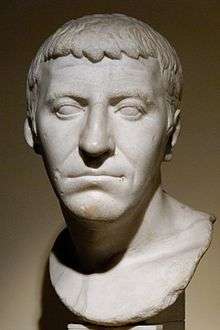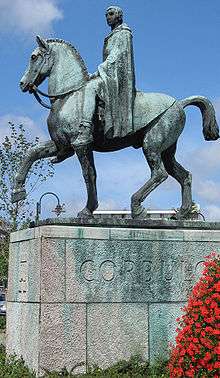Gnaeus Domitius Corbulo

Gnaeus Domitius Corbulo (c. 7 – 67 AD) was a Roman general, brother-in-law of the emperor Caligula and father-in-law of Domitian.
Life
Descent
Corbulo was born in Italy into a senatorial family. His father, who shared the same name, entered the Senate as a formal praetor under Tiberius. His mother Vistilia came from a family which held the praetorship.
Military and political career
Reign of Caligula
Corbulo's early career is unknown but he was consul in 39 AD during the reign of Caligula, his brother-in-law through Caligula's marriage to Corbulo's half-sister Milonia Caesonia.
In Germania Inferior

After Caligula's assassination, Corbulo's career came to a halt until, in 47 AD, the new Emperor Claudius made him commander of the armies in Germania Inferior, with base camp in Colonia (Cologne).
The new assignment was a difficult one and Corbulo had to deal with major rebellions by the Germanic Cherusci and Chauci. During his stay in Germania, the general ordered the construction of a canal between the rivers Rhine and Meuse.[1] Parts of this engineering work, known as Fossa Corbulonis or Corbulo's Canal, have been found at archeological digs. Its course is about identical to the Vliet, which connects the modern towns of Leiden (ancient Matilo) and Voorburg (Forum Hadriani). Upon reaching lower Germania, Corbulo employed both the army and naval squadrons of the fleet patrolling the Rhine and North Sea, eventually expelling the Chauci away from the Roman Provinces and instituting a rigorous training program in order to ensure maximum effectiveness of his legions. He supposedly executed two legionnaires after they were found to have laid aside their swords when labouring in the construction of fortifications on a marching camp.[2] Corbulo is said to have said, "You defeat the enemy with a pickaxe." [3]
In the east
Corbulo returned to Rome, where he stayed until 52 AD, when he was named governor of the province of Asia. Following Claudius' death in 54 AD, the new emperor Nero sent him to the eastern provinces to deal with the Armenian question. After some delay, and reinforced by troops from Germany, in 58 he took the offensive, and attacked Tiridates, King of Armenia and brother of Vologases I of Parthia. Artaxata and Tigranocerta were captured by his legions (III Gallica, VI Ferrata, and X Fretensis), and Tigranes, who had been brought up in Rome and was an obedient servant of the government, was installed as king of Armenia.
In 61 AD Tigranes invaded Adiabene, an integral portion of the Parthian Kingdom, and a conflict between Rome and Parthia seemed unavoidable. Instead Vologases thought it better to come to terms. It was agreed that both Roman and Parthian troops should evacuate Armenia, that Tigranes should be dethroned, and the rule of Tiridates recognized. The Roman government declined to accede to these arrangements, and Lucius Caesennius Paetus, governor of Cappadocia, was ordered to settle the question by bringing Armenia under direct Roman administration.
The protection of Syria claimed all of Corbulo's attention in the meantime. Paetus, a weak and incapable commander who "despised the fame acquired by Corbulo", suffered a severe defeat at Rhandeia in 62 AD, where he was surrounded and forced to capitulate to the Parthians and evacuated to Armenia. Command was again entrusted to Corbulo. In 63 AD, with a strong army, he crossed the Euphrates. Tiridates declined to give battle and arranged a peace. At Rhandea he laid down his diadem at the foot of the emperor's statue, promising not to resume it until he received it from the hand of Nero himself in Rome.
Fall and death
After two failed plots by noblemen and senators, including Corbulo's son-in-law, the senator Lucius Annius Vinicianus, to overthrow Nero in 62 AD, Nero became suspicious of Corbulo and his support among the Roman masses. In 67 AD disturbances broke out in Judaea and Nero, ordering Vespasian to take command of the Roman forces, summoned Corbulo, as well as two brothers who were the governors of Upper and Lower Germany, to Greece. On his arrival at Cenchreae, the port of Corinth, messengers from Nero met Corbulo and ordered him to commit suicide. He loyally obeyed, and fell on his own sword, saying, "Axios!".[4]
Works
Corbulo wrote a now-lost account of his Asiatic experiences.
Marriage and issue
Corbulo married Cassia Longina, a Roman woman from a senatorial family, daughter of Gaius Cassius Longinus and his wife Junia Lepida. Cassia bore Corbulo two daughters. The elder daughter Domitia married the senator Lucius Annius Vinicianus and their second daughter Domitia Longina married the future Roman Emperor Domitian and later became a Roman Empress. Through Junia Lepida, a great-great granddaughter of Augustus, both of Cassia's daughters by Corbulo were direct descendants of the first Roman emperor and ,consequently, surviving members of the Imperial Julio-Claudian family.
In popular culture
- The 2012 live-action video web series Forward Unto Dawn takes place in the fictional Corbulo Academy of Military Science,[5] which is named after General Corbulo. The academy's motto is Axios!, which Corbulo said before killing himself.
- The 2012 historical novel, Avenger of Rome, by Douglas Jackson, deals with the fictional last battle of Corbulo.
Notes
- ↑ Tacitus Annales XI 20.
- ↑ Goldsworthy, Adrian (2003). In the Name of Rome: The men who won the Roman Empire. Great Britain: Orion Publishing Group. p. 268. ISBN 0-297-84666-3.
- ↑ Strauss, Barry S. The Spartacus War. Simon & Schuster, 2009. Print.
- ↑ "The game of death in ancient Rome: arena sport and political suicide"
- ↑ "Halopedia: Corbulo Academy of Military Science"
References
 This article incorporates text from a publication now in the public domain: Chisholm, Hugh, ed. (1911). "article name needed". Encyclopædia Britannica (11th ed.). Cambridge University Press.
This article incorporates text from a publication now in the public domain: Chisholm, Hugh, ed. (1911). "article name needed". Encyclopædia Britannica (11th ed.). Cambridge University Press.- Military History, Vol. 23, Number 5, p. 47–53
External links
| Political offices | ||
|---|---|---|
| Preceded by Marcus Aquila Iulianus and Publius Nonius Asprenas |
Suffect Consul of the Roman Empire suffect consul under Caligula with Lucius Apronius Caesianus; and Quintus Sanquinius Maximus, Domitius Afer, Aulus Didius Gallus suffects 39 AD |
Succeeded by Caligula without colleague |